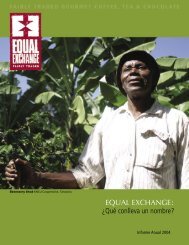What's Fair Game - Equal Exchange
What's Fair Game - Equal Exchange
What's Fair Game - Equal Exchange
Create successful ePaper yourself
Turn your PDF publications into a flip-book with our unique Google optimized e-Paper software.
A LESSON FOR THE CLASSROOMAdapted from a lesson by Global Connections.learning about cocoa farmersMATERIALS NEEDEDCocoa beans (if available), an <strong>Equal</strong> <strong>Exchange</strong>chocolate bar, a lot of scrap paper, scissors,five calculators (one for each group), a copyof the “What’s <strong>Fair</strong> <strong>Game</strong> Cards” cut up, fivecopies of the “What’s <strong>Fair</strong> Group AccountingRecord” cut up.CLASSROOM NARRATIVEWARM UP: You are going to be cocoa farmers.Do you like chocolate? What is your favoritekind of chocolate? What chocolate is made from?(Have an <strong>Equal</strong> <strong>Exchange</strong> chocolate bar nearbyso students can read the ingredients if they don’tknow them: milk, cocoa beans and sugar.) Wheredo these ingredients come from? (Milk comesfrom all over the world. Cocoa beans and sugar aregrown in Africa, and South and Central America,where it’s hot.)We’re going to learn a little bit about what it’s liketo be cocoa farmers in the Dominican Republic.ACTIVITY: Ask students to find the DominicanRepublic on a world map and imagine what theweather is like there.Divide the class into five groups of farmers.Tell them they are going to pretend they are allfarmers growing cocoa beans. Tell them Group #5is a farmer cooperative called CONACADO whichsells its beans to <strong>Equal</strong> <strong>Exchange</strong>, a <strong>Fair</strong> Tradecooperative. The others are traditional cocoafarmers.If cocoa beans are available, pass them around toeach group and ask them to examine the beans.DIALOGUE: What do you notice about the beans?How do they feel? What do they smell like? Didyou know chocolate is made from cocoa beans?ACTIVITY: Give each group a stack of scrap paperand scissors. Explain they will be drawing cocoabeans on the paper and cutting them out insteadof really growing them. Encourage them to drawsimple outlines of cocoa beans because speed isimportant in cocoa production. Tell them their jobis to work together to draw and cut out as manybeans as possible in one minute. Show them anexample of the kind of cocoa bean they are goingto grow. Give each group a few minutes to discusshow they are going to get a good crop this year.TO PLAY: Give the groups exactly 60 secondsto draw and cut out cocoa beans. (You can giveyounger students more time if they are workingslowly.) Ask each farmer group to count up thebeans they have grown and write the total ontheir “What’s <strong>Fair</strong> Group Accounting Record.”Then give each group one good and one bad“What’s <strong>Fair</strong> <strong>Game</strong> Card.” Go around to eachfarmer group, asking one student from eachgroup to read their cards out to the class. Give ortake away beans as required and ask each groupto record the number of beans they gained, thenumber they lost, and the number they’ve endedup with on their “What’s <strong>Fair</strong> Group AccountingRecord.” Tell them their final total is the numberof beans they have managed to grow this year.Explain that the currency in the DominicanRepublic is the Dominican Republic peso, andthat you are going to pretend the market price forcocoa is two pesos per cocoa bean.Choose five students to pretend they are CocoaBuyers. Have each Buyer meet with their groupone by one and act out the transaction describedin the “Buyer Instructions” while the other groupswatch. Have the farmer groups write down ontheir “What’s <strong>Fair</strong> Group Accounting Record” howmuch they earned for their beans.
What’s <strong>Fair</strong> <strong>Game</strong> CardsCut out these cards and give each group of farmers one good card and one bad card.GOOD CARDSThe weather has been very goodand your beans have grown well.ADD 40 EXTRA BEANSYour beans do not get anydiseases this year.ADD 30 EXTRA BEANSYou buy natural pesticides in bulkwith other farmers and save money.ADD 20 EXTRA BEANSYour hoe breaks,but you mend it yourself.ADD 10 EXTRA BEANSYou share tools with other farmersand save money.ADD 20 EXTRA BEANSYour beans do not getany diseases this year.ADD 30 EXTRA BEANSBAD CARDSA storm has destroyedhalf of your trees.GIVE BACK HALF YOUR BEANSYour hoe breaksand you have to buy a new onebecause you can’t fix it.GIVE BACK 10 BEANSYour mother is ill. You have toborrow money to buy medicine.GIVE BACK 20 BEANSYour hoe breaksand you have to buy a new onebecause you can’t fix it.GIVE BACK 10 BEANSYour cocoa beans are drying on the racksand it rains. Some beans spoil.GIVE BACK ONE QUARTEROF YOUR BEANSException: If group 5 gets this card, they give nothing backbecause they have a drying barn to protect their crop.Some of your trees have caughta disease called black pod.GIVE BACK ONE FIFTHOF YOUR BEANS
What’s <strong>Fair</strong>Buyer InstructionsBuyer InstructionsGROUP 1 Pay two pesos per bean. Say youwill pay them by check, but if they protest, paythem in cash. Be civil and efficient.GROUP 2 Take the beans and put themin your desk or bag. Then pay one peso perbean in cash. Treat the farmers rudely. If theycomplain, just leave with their beans.GROUP 3 Pay two pesos per beans, butcheat them, paying for five less beans thanthey have. If they question you, be evasiveand in a hurry. If they complain, tell themthere aren’t any other buyers for 30 miles.Take it or leave it.GROUP 4 Pay them two pesos per beanbut pay them with a check. If they complain,tell them there aren’t any other buyers for 30miles. Take it or leave it.GROUP 5 Be very friendly. Tell them youare their <strong>Fair</strong> Trade Buyer and that you’re soglad to get a chance to come down and seethem again. You just love coming down tovisit the farmers in CONACADO, the cocoafarmer cooperative who sells to your company.Remind them that you agreed to pay themthree pesos per bean or more if the marketprice is higher so that they can make a goodliving this year and grow their crops in a waythat’s good for the environment. Check withthem to see if they think three pesos per beanwill be enough next year. If they need more,say you’ll talk with people at your companyand come back to make a new agreementbefore the next growing season starts. Thenhappily pay them the three pesos per bean.Talk with each farmer about their families andabout the school the cooperative members aregoing to build this year for their children.












